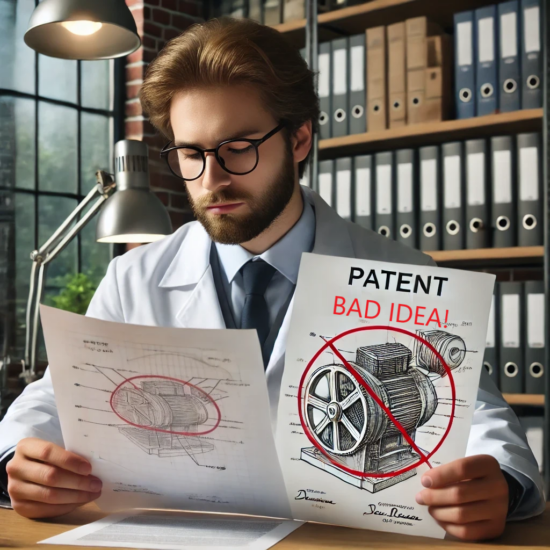
One of the requirements to be granted a patent under US patent law is that the invention is not obvious in view of the technology that has come before the invention ("prior art"). There are many bases for demonstrating that an invention is non-obvious. One special form of argument is that the prior art teaches away from the claimed invention. A prior art reference is said to teach away from a claimed invention when it criticizes, discredits, or otherwise discourages the path taken by the inventor. The Federal Circuit has repeatedly addressed teaching away arguments, and finds that they are valid bases for establishing non-obviousness under 35 U.S.C. § 103 if the prior art can be reasonably said to teach away from the invention.
A prior art reference teaches away when it discourages a person of ordinary skill in the relevant art (the field of technology) from developing the applicant's invention. Santarus, Inc. v. Par Pharm., Inc., 694 F.3d 1344 (Fed. Cir. 2012). This means the prior art teaches that Applicant's claimed invention is unlikely to work or be beneficial. In contrast, in In re Gurley, 27 F.3d 551 (Fed. Cir. 1994), the court affirmed an obviousness rejection, noting that prior art's mere disclosure of alternatives does not automatically establish non-obviousness unless there is clear discouragement from pursuing the applicant’s path. Thus, a teaching away argument is valid if sufficiently supported by the prior art reference.
The Federal Circuit has further clarified that a reference teaches away if a person of ordinary skill would be led in a direction divergent from the solution claimed in the patent application. For instance, in Polaris Indus. v. Arctic Cat Inc., 882 F.3d 1056 (Fed. Cir. 2018), the court vacated a PTAB IPR obviousness determination, stating that dismissing a teaching away as a mere disclosure of one reference's mere preference was improper.
Teaching away can be best demonstrated by cases applying the concept. We provide briefs on several important cases dealing with teaching away.
In Chemours Co. FC, LLC v. Daikin Indus., Ltd., 4 F.4th 1370 (Fed. Cir. 2021), the Federal Circuit reversed the PTAB’s obviousness rejection, holding that the prior art reference teaches away when it explicitly discourages a skilled artisan from modifying a prior art reference in the manner necessary to reach the claimed invention. The claimed invention in Chemours involved a melt flow rate range of 30 ± 3, whereas the primary reference disclosed a melt flow rate range of “15 or greater,” with an example of 24.
The Federal Circuit focused on the fact that the prior art reference explicitly cautioned against high melt flow rates, stating that higher melt flow rates lead to poor mechanical properties. This language was pivotal because it showed that a skilled artisan would have been discouraged from increasing the melt flow rate to the claimed range. The court found that the PTAB improperly relied on other prior art references that were not concerned with the specific mechanical property issues the applicant's invention sought to solve. Consequently, the reference teaches away from the claimed range, making the modification non-obvious.
In Galderma Labs., L.P. v. Tolmar, Inc., 737 F.3d 731 (Fed. Cir. 2013), the Federal Circuit reversed a district court finding of non-obviousness, emphasizing that prior art teaches away when it explicitly states that a claimed concentration range would be ineffective or undesirable. The dispute concerned a patent covering a 0.3% adapalene formulation, used for treating acne, and whether this formulation was obvious in view of prior art disclosing 0.1% adapalene formulations.
The court found that the prior art reference teaches away by stating that increasing the adapalene concentration above 0.1% would not provide additional therapeutic benefit and would likely lead to increased side effects. Specifically, the prior art noted that higher concentrations of adapalene caused increased irritation without significant therapeutic gain. This clear discouragement from using concentrations above 0.1% supported the teaching away argument, making it improper to combine references that suggested merely a general preference for lower concentrations. The court emphasized that prior art's mere disclosure of alternatives does not override an explicit teaching away when the reference criticizes, discredits, or otherwise discourages investigation into a particular alternative.
In Bayer Pharma AG v. Watson Labs., Inc., 874 F.3d 1316 (Fed. Cir. 2017), the Federal Circuit reversed a finding of non-obviousness, holding that teaching away does not require a reference to explicitly discourage a particular alternative. Instead, a reference teaches away if it expresses a general preference for one approach while discrediting another.
The court focused on prior art references that discussed micronized drospirenone formulations in pharmaceutical compositions. The references suggested that micronization was critical for proper absorption and bioavailability. Specifically, the prior art reference stated that "poor bioavailability results when drospirenone is administered in a non-micronized form," and that "micronization is necessary to achieve the desired therapeutic effects." The Federal Circuit found that this language taught away from the claimed feature of using non-micronized drospirenone in the patent claim at issue. By strongly emphasizing the necessity of micronization, the prior art did not merely express a reference's mere preference but actively discouraged pursuing the claimed invention.
In Millennium Pharm. v. Sandoz Inc., 862 F.3d 1356 (Fed. Cir. 2017), the Federal Circuit reversed a district court's obviousness determination, concluding that the prior art reference teaches away from the claimed invention. The claimed invention involved a stable formulation of bortezomib, a drug used to treat multiple myeloma, by creating an ester with mannitol.
The prior art reference at issue, U.S. Patent No. 5,780,454, described bortezomib but explicitly stated that lyophilization (freeze-drying) was the preferred method of stabilization. Moreover, the reference warned against forming esters with bortezomib due to the risk of forming multiple esters with different chemical and biological properties, which could render the drug unstable or ineffective.
The Federal Circuit emphasized that this cautionary language in the prior art reference constituted teaching away, as it would have led a person of ordinary skill to avoid creating an ester with mannitol. The court noted that the prior art teaches a preferred embodiment that discourages the claimed approach and underscores the direction divergent from the applicant’s solution. This ruling reinforced the principle that known methods with discouraging consequences may serve as strong teaching away arguments against obviousness rejections and invalidity challenges.
When evaluating whether prior art teaches away, the Federal Circuit has emphasized that courts must consider prior art as a whole, not merely isolated disclosures within a single reference. The importance of a holistic analysis was firmly established in W.L. Gore & Assocs., Inc. v. Garlock, Inc., 721 F.2d 1540 (Fed. Cir. 1983), where the court reversed a finding of obviousness, criticizing the lower court for improperly evaluating references in isolation rather than assessing the developments flowing from them collectively.
In W.L. Gore, the prior art reference at issue disclosed expanded polytetrafluoroethylene (ePTFE) products but explicitly warned against stretching the material beyond certain limits, stating that doing so would lead to mechanical failures. The Federal Circuit determined that this warning constituted a teaching away argument against the claimed invention, which sought to push those boundaries. The court emphasized that "[t]o ignore statements in prior art references that caution against a particular combination is to improperly dissect the reference and fail to consider the teaching as a whole." Consequently, the Federal Circuit underscored that a reference's mere preference for one approach does not negate teaching away where explicit discouragement exists.
By reaffirming that prior art must be analyzed in its entirety, the Gore decision prevents improper hindsight reasoning and ensures that courts and the patent examiner properly consider the full scope of disclosures. Citing authorities consistently emphasize that references must be read in their full context to determine whether they encourage or discourage the solution claimed.
The Federal Circuit has recognized that teaching away may be indirect, meaning that prior art need not explicitly warn against an invention but may still discourage a skilled artisan from pursuing the claimed approach. This can occur when all prior solutions to a problem follow a similar path, implying that alternative approaches would not be effective or desirable.
In Spectralytics, Inc. v. Cordis Corp., 649 F.3d 1336 (Fed. Cir. 2011), the court found that teaching away does not require a prior reference to foresee and explicitly reject the applicant's invention. Instead, the Federal Circuit held that prior art teaches away when it consistently suggests that only one approach is viable, implicitly discouraging any alternative methods.
In Spectralytics, the claimed invention was a laser cutting method for manufacturing medical devices. The defendant argued that prior art references did not explicitly discourage the use of the claimed technique. However, the court found that all existing references consistently used mechanical cutting, without considering laser cutting as an alternative. The court ruled that this pervasive general preference amounted to teaching away, as it implicitly suggested that laser cutting was not a viable option. The basis for the Federal Circuit's holding was that teaching away may be inferred when prior art references overwhelmingly favor one method to the exclusion of others, thereby discouraging one of ordinary skill from even considering an alternative approach.
Thus, teaching away may be indirect when the prior art teaches a single viable path, making other paths appear unworkable or less favorable, even if they are not explicitly criticized. This concept is particularly important when analyzing patent claims involving emerging technologies, where prior art might favor a traditional method and inadvertently deter innovation through implicit discouragement.
In In re Gordon, 733 F.2d 900 (Fed. Cir. 1984), the Federal Circuit found teaching away where a reference expressly discouraged a modification due to technical or practical concerns. If prior art indicates that a modification is too costly to be practical, that could serve as a teaching away argument. If the economic burdens associated with a modification were substantial, a skilled artisan would likely be dissuaded from pursuing that path.
However, in Grit Energy Solutions, LLC v. Oren Techs., LLC, 957 F.3d 1309 (Fed. Cir. 2020), the Federal Circuit clarified that cost concerns alone do not automatically establish a teaching away argument. The court held that while increased costs might be a relevant consideration, they must be coupled with other discouraging factors, such as technical infeasibility or commercial impracticality, to constitute teaching away. The ruling emphasized that a mere increase in price does not necessarily mean that a reference teaches away if there remains a reasonable motivation to modify the prior art reference despite cost concerns.
The Federal Circuit has acknowledged that post-reference developments may negate alleged teaching away. In Magseis FF LLC v. Seabed Geosolutions (US) Inc., 857 F. App'x 651 (Fed. Cir. 2021), the court upheld an obviousness rejection, ruling that while the initial prior art reference teaches away, subsequent advancements had rendered the prior concerns obsolete. The case involved seismic survey technology, where earlier references discouraged a particular ocean-bottom node deployment method due to perceived inefficiencies. However, new technological developments had since mitigated those inefficiencies, leading the court to conclude that the prior teaching away no longer applied. The court reasoned that a teaching away argument must be assessed in light of later developments that could overcome previously perceived drawbacks, emphasizing that an obviousness determination should incorporate advances that would have been known to a skilled artisan at the time of the invention.
For patent practitioners, effectively presenting a teaching away argument requires a nuanced approach that demonstrates how the prior art reference explicitly discourages pursuit of the claimed invention. This argument is particularly powerful in overcoming obviousness rejections, especially when prior references appear to favor alternative approaches that are inconsistent with the solution claimed in the patent claim.

The doctrine of teaching away remains an important concept in patent law, frequently arising in PTAB decisions and Federal Circuit rulings. Courts assess whether a prior art reference teaches away by considering whether it criticizes, discredits, or otherwise discourages the claimed feature. The Supreme Court has emphasized that common sense and skill in the art must guide the analysis, ensuring that citing authorities correctly interpret prior art in the same field. The evolving case law surrounding teaching away continues to shape how inventive concept arguments are litigated.
© 2025 Sierra IP Law, PC. The information provided herein does not constitute legal advice, but merely conveys general information that may be beneficial to the public, and should not be viewed as a substitute for legal consultation in a particular case.

"Mark and William are stellar in the capabilities, work ethic, character, knowledge, responsiveness, and quality of work. Hubby and I are incredibly grateful for them as they've done a phenomenal job working tirelessly over a time span of at least five years on a series of patents for hubby. Grateful that Fresno has such amazing patent attorneys! They're second to none and they never disappoint. Thank you, Mark, William, and your entire team!!"
Linda Guzman

Sierra IP Law, PC - Patents, Trademarks & Copyrights
FRESNO
7030 N. Fruit Ave.
Suite 110
Fresno, CA 93711
(559) 436-3800 | phone
BAKERSFIELD
1925 G. Street
Bakersfield, CA 93301
(661) 200-7724 | phone
SAN LUIS OBISPO
956 Walnut Street, 2nd Floor
San Luis Obispo, CA 93401
(805) 275-0943 | phone
SACRAMENTO
180 Promenade Circle, Suite 300
Sacramento, CA 95834
(916) 209-8525 | phone
MODESTO
1300 10th St., Suite F.
Modesto, CA 95345
(209) 286-0069 | phone
SANTA BARBARA
414 Olive Street
Santa Barbara, CA 93101
(805) 275-0943 | phone
SAN MATEO
1650 Borel Place, Suite 216
San Mateo, CA, CA 94402
(650) 398-1644. | phone
STOCKTON
110 N. San Joaquin St., 2nd Floor
Stockton, CA 95202
(209) 286-0069 | phone
PORTLAND
425 NW 10th Ave., Suite 200
Portland, OR 97209
(503) 343-9983 | phone
TACOMA
1201 Pacific Avenue, Suite 600
Tacoma, WA 98402
(253) 345-1545 | phone
KENNEWICK
1030 N Center Pkwy Suite N196
Kennewick, WA 99336
(509) 255-3442 | phone
2023 Sierra IP Law, PC - Patents, Trademarks & Copyrights - All Rights Reserved - Sitemap Privacy Lawyer Fresno, CA - Trademark Lawyer Modesto CA - Patent Lawyer Bakersfield, CA - Trademark Lawyer Bakersfield, CA - Patent Lawyer San Luis Obispo, CA - Trademark Lawyer San Luis Obispo, CA - Trademark Infringement Lawyer Tacoma WA - Internet Lawyer Bakersfield, CA - Trademark Lawyer Sacramento, CA - Patent Lawyer Sacramento, CA - Trademark Infringement Lawyer Sacrament CA - Patent Lawyer Tacoma WA - Intellectual Property Lawyer Tacoma WA - Trademark lawyer Tacoma WA - Portland Patent Attorney - Santa Barbara Patent Attorney - Santa Barbara Trademark Attorney